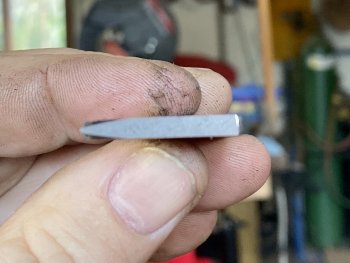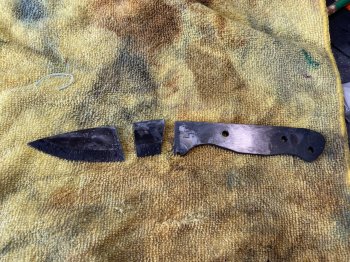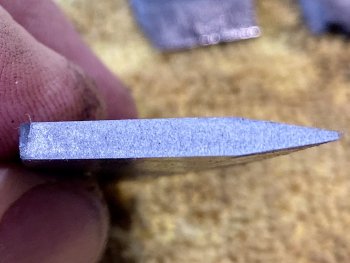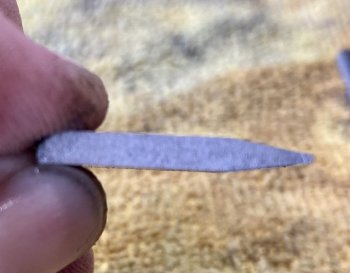You are using an out of date browser. It may not display this or other websites correctly.
You should upgrade or use an alternative browser.
You should upgrade or use an alternative browser.
It was time to check grain
- Thread starter Chris Railey
- Start date
JeremyBartlett
Well-Known Member
Honestly it looks a little course to me. The grain should look silky and smooth. I have to ask the normal questions when it comes to grain. Is this forged or stock removal, did you do any normalizing, what type of steel, and what process did you use to get that result...
Chris Railey
Well-Known Member
I needed to test it because this is the first steel I have used from a different supplier. Because it was a first test I did no normalizing. It is stock removal hardened in a forge using simple HT. The next one I will normalize to see if it helps. I have seen worse grain but I normally get better.
Sean Jones
Well-Known Member
Looks fairly course to me as well.Honestly it looks a little course to me. The grain should look silky and smooth. I have to ask the normal questions when it comes to grain. Is this forged or stock removal, did you do any normalizing, what type of steel, and what process did you use to get that result...
About the best way I've found to tell if grain is like it should be is to break an old file and hold that broken file next to the broken test piece. If it looks like the broken file, then it's good. The file will look like a greyish color with almost actual grain visible to the naked eye. Seems like I can see grain in that, so a tad coarse?
Rather than profiling a full blade why not a test coupon for checking grain?
Rather than profiling a full blade why not a test coupon for checking grain?
Chris Railey
Well-Known Member
About the best way I've found to tell if grain is like it should be is to break an old file and hold that broken file next to the broken test piece. If it looks like the broken file, then it's good. The file will look like a greyish color with almost actual grain visible to the naked eye. Seems like I can see grain in that, so a tad coarse?
Rather than profiling a full blade why not a test coupon for checking grain?
Testing was an afterthought because I did not remember I had not tested the new steel until after I profiled it. I decided to sacrifice the knife to check the grain.
J. Doyle
Dealer - Purveyor
Agree with the others. It looks pretty coarse to me.
What type of steel? Was it tempered?
I hope Kevin sees this and weighs in and I don't want to speak out of turn but I believe if a visual inspection of the grain is the goal, it should be un-tempered so you get a good clean snap and not the distortion or stretching/tearing that might occur with the extra toughness that tempering would add.
What type of steel? Was it tempered?
I hope Kevin sees this and weighs in and I don't want to speak out of turn but I believe if a visual inspection of the grain is the goal, it should be un-tempered so you get a good clean snap and not the distortion or stretching/tearing that might occur with the extra toughness that tempering would add.
Chris Railey
Well-Known Member
It was not tempered just quenched and broken once it was cool. I think a couple of normalizing cycles may help it out. It’s 1080. The upside is it broke like glass.
tkroenlein
Well-Known Member
I'd like to know where the steel was sourced, if you don't mind sharing.
Chris Railey
Well-Known Member
No, I have no way to test the Rockwell.Were you able to measure the Rockwell hardness?
It looks coarse to me as well.
Sending out the Kevin signal...




